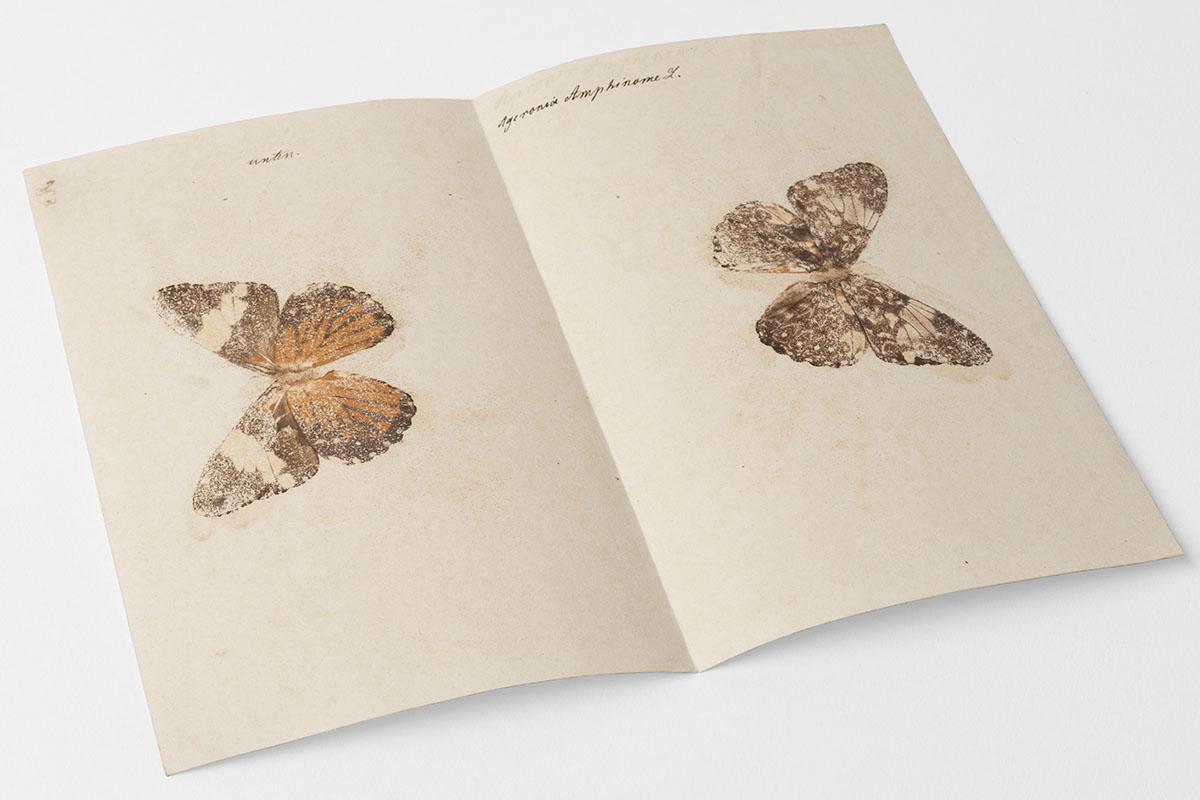Yvonne Reimers
A folded sheet of paper, 18.3 x 22.7 cm in size and stamped "Bibliothek Zoologisches Museum Berlin" on the verso, reveals the mirrored image of a butterfly. Above the motif on the left side, the note "below" is handwritten in ink, on the right side we read "Ageronia Amphinome L.". The two pictures appear powdery, the wings are covered with fine colour pigments in blue, black, green, and red, which spread out across the pages. An insert prevents the two images from touching when the paper is folded. The body of the butterfly is pigmented mostly in the centre, its upper and lower edges are each outlined with fine strokes of pencil. Slight impressions of the butterfly shine through on the reverse.
This object goes back to the bequest of the gardener and natural scientist Friedrich Sellow (1789–1831), who travelled to South America on behalf of Prussia between 1814 and 1831 and accompanied numerous scientific expeditions. After Sellow left parts of his bequest to his friend Ignaz von Olfers (1793–1871), general director of the Royal Museums in Berlin, it was handed down to the Museum für Naturkunde in 1882 together with a collection of minerals and rocks. In 1968 the bequest was transferred from the Mineralogical Collection to the Historical Division.
At first sight, one might mistake these images for detailed colour drawings of a butterfly. However, they are the result of a process that is often referred to as nature printing: so-called lepidochromes. In this process, the butterfly specimen was pressed onto the paper like a stamp. In order to achieve this, the paper was first treated with a special fixing liquid. The butterfly was then placed on the sheet, which was folded and pressed together tightly so that the butterfly’s scales stuck onto the paper. The specimens were destroyed in this process and became worthless as collection objects. Although not (yet) proven, it is possible that Friedrich Sellow had mastered this process and produced the five lepidochromes himself during his travels in South America.
Organic materials are not uncommon in the holdings of the Historical Division. In particular, feathers, fish scales, or small insects are often found among the images and written documents. This raises a number of questions: Which role did so-called nature printing play in nineteenth-century scientific research? Which qualities were they well-equipped to illustrate, better than, for example, drawings or photographs? Are they images, documents, or collection objects? How and where should archivists store these fragile imprints in accordance with conservation standards and which keywords should they use to index these items? And finally: is an animal a document?
Object Profile
- Title: lepidochrome of a butterfly
- Signature: ZM B VIII 14
- Provenance: bequest Friedrich Sellow (1789–1831), Mineralogical Collection since 1882, Historical Division of the Museum für Naturkunde since 1968
- Materials: paper, pencil, scales of a butterfly, ink
- Author: likely Friedrich Sellow (1789–1831)
- Date of production: not dated, ca. 1814–1831
- Place of production: likely Brazil
- Keywords: lepidochrome, nature printing, butterflies, Sellow, Brazil
Bibliography
- Suzanne Briet: Qu'est-ce que la documentation?, Paris 1951.
- Roderick Cave: Impressions of Nature: A History of Nature Printing, London 2010.
- Lorraine Daston und Peter Galison: Objektivität, Frankfurt a. M. 2007, esp. pp. 114 ff.
- Carsten Eckert, Sabine Hackethal and Hanns Zischler: Die Erkundung Brasiliens. Friedrich Sellows unvollendete Reise, Berlin 2013.
- Sabine Hackethal and Frank Tillack: "Im Auftrag Preußens. Friedrich Sellow in Brasilien (1814–1831)", in: Amphibien und Reptilien der Neotropis. Entdeckungen deutschsprachiger Forscher in Mittel- und Südamerika, ed. by Axel Kwet and Manfred Niekisch, Rangsdorf 2016, pp. 64–79.
- Jean Orousset: "Un art oublié. La lépidochromie", in: L’Entomologiste, vol. 64 (2008), no. 1, pp. 47–58.
- H. Poulin: La Lépidochromie. L'Art de décalquer et de fixer les couleurs des ailes du papillon, Paris 1899.
- Simon Weber-Unger (ed.): Naturselbstdrucke. Dem Originale identisch gleich, Vienna 2014.
Image Credits
- Lepidochrome of a butterfly, pencil, scales of a butterfly, and ink on paper, possibly by Friedrich Sellow, not dated (ca. 1814–1831), 18.3 x 22.7 cm, MfN, HBSB, ZM B VIII 14, © Hwa Ja Götz, MfN.
